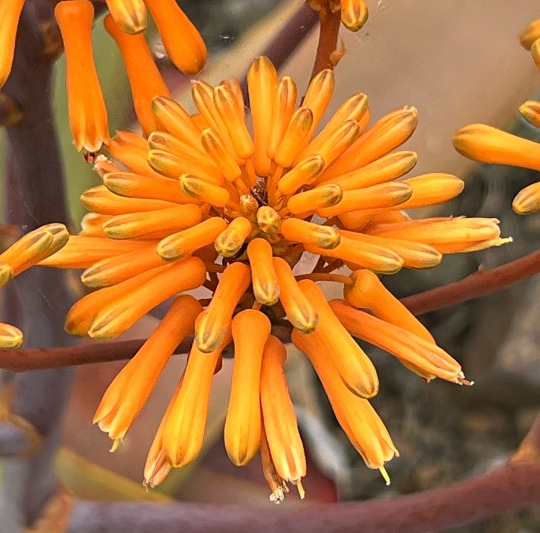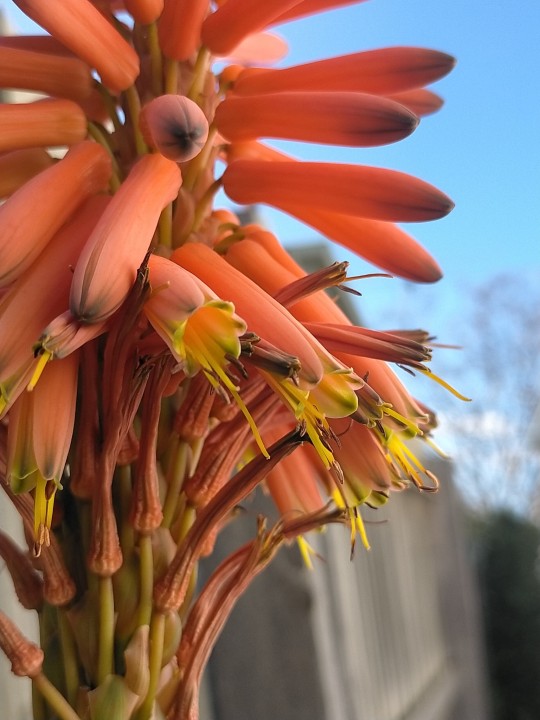#Asphodelaceae
Text

Hemerocallis fulva 'Barbara Mitchell' / 'Barbara Mitchell' Daylily at the Sarah P. Duke Gardens at Duke University in Durham, NC
#Hemerocallis fulva 'Barbara Mitchell'#Hemerocallis fulva#Hemerocallis#Asphodelaceae#Barbara Mitchell Daylily#Orange Daylily#Tawny Daylily#Ditch lily#Outhouse lily#Fulvous Daylily#Tiger Daylily#Daylily#Day lily#Plants#Flowers#Nature photography#photography#photographers on tumblr#Sarah P. Duke Gardens#Duke Gardens#Duke University#Durham#Durham NC#North Carolina#🌺🌻#Corn lily#Fourth of July lily#Roadside Daylily#Wash-house lily
204 notes
·
View notes
Text


Aloe buhrii (orange)
This Aloe species belongs to a group whose best known member is Aloe striata. However, Aloe buhrii is a much rarer plant in nature and comes from farther to the northwest in the winter-rainfall region. This makes it an ideal choice for Mediterranean-climate gardens, and it is an excellent spring bloomer in our part of California. Its flowers come in yellow or orange - the orange form is pictured here.
-Brian
157 notes
·
View notes
Text

Asfodelo giallo (Asphodeline lutea (L.) Rchb., Asphodelaceae)
22 notes
·
View notes
Text

Christmas Aloe
Aloe comptonii
Swartberg, Meiringspoort, South Africa
-33.432158, 22.55888
by madabotanik
#plants#botany#aloe#aloes#aloe comptonii#south africa#swartberg#inaturalist#nature#asphodelaceae#asparagales#south africa tag#m
22 notes
·
View notes
Text

🪁 (Haworthia reticulata var. hurlingii)
59 notes
·
View notes
Photo

Aloe mutabilis by dieterscriba https://flic.kr/p/2i3TXQ6
36 notes
·
View notes
Text



Aloe cv.
02-AUG-2023
Melbourne, Vic
#australia#victoria#melbourne#flowers#orange#orange flowers#succulents#asparagales#asphodelaceae#asphodeloideae#aloeae#aloe
2 notes
·
View notes
Text
#2227 - Dianella nigra - Ink Berry


AKA New Zealand blueberry, or turutu.
A perennial herb of the Asphodelaceae, subfamily Hemerocallidoideae, endemic to New Zealand. The berries are bright blue and attractive to birds, but humans find them very bitter and they may be poisonous if eaten in large amounts.
New Zealand has one other Dianella species, but some occur in Africa, South-east Asia, and other the Pacific Islands including Hawaii, but about half of the species are native to Australia.
Craters of the Moon, Taupo Volcanic Zone, New Zealand
1 note
·
View note
Photo

Aloe vera, llamado sábila, acíbar o áloe de Barbados, entre otros, es una especie suculenta de la familia Asphodelaceae. Con unas quinientas especies, el aloe está ampliamente distribuido y se considera una especie invasora en muchas regiones del mundo. #AloeVera #Aloe #Sabila #Acibar #AloeDeBarbados #Suculenta #Asphodelaceae (en Mendoza, Argentina) https://www.instagram.com/p/CkMAeq7JcyM/?igshid=NGJjMDIxMWI=
0 notes
Text

Hemerocallis x 'White Eyes Pink Dragon' / 'White Eyes Pink Dragon' Daylily at the Sarah P. Duke Gardens at Duke University in Durham, NC
#Hemerocallis x 'White Eyes Pink Dragon'#Hemerocallis#Asphodelaceae#White Eyes Pink Dragon Daylily#yu gi oh#Daylily#Flowers#Plants#Nature photography#photography#photographers on tumblr#Sarah P. Duke Gardens#Duke Gardens#Duke University#Durham#Durham NC#North Carolina#🌺🌻
18 notes
·
View notes
Text


Haworthiopsis coarctata
All of the species now placed in Haworthiopsis were formerly put in Haworthia, so this plant is usually seen labeled that way. As a group, Haworthiopsis tend to have more rigid leaves, often with raised white markings on their leaves, and sometimes with a columnar growth habit (as is the case with H. coarctata). The small white flowers with darker stripes are not very showy, but the plant itself is wonderful! If grown in the shade, this species is quite green, but with a little more light it takes on beautiful tinges of red, orange or purple. Native to South Africa's Eastern Cape Province.
-Brian
68 notes
·
View notes
Text


A - Asphodelus cerasifer J.Gay - Asfodelo maggiore (Asphodelaceae)
40 notes
·
View notes
Text
Aloe Vera
Aloe Barbadensis Miller
Aloe Vera Variety Chinensis

Aloe Barbadensis Miller - Edible

Aloe vera variety Chinensis - Not Edible

Comparison
Background Information
Alternative Names:
Plant Type: Succulent Evergreen Perennial
Higher Classification: Aloes
Family: Asphodelaceae (Liliaceae)
Order: Asparagales
Habitat: Arid climates; Africa, India, Arabian Peninsula
Environment: 55 - 80 degrees fahrenheit, does well indoors
Zones: 8 - 11
Invasive: It is invasive in many world regions.
Identification:
Aloe vera barbadensis Miller has thick, wide, fleshy upright leaves which are gray-green in colour, and are arranged in a very distinct circular rosette form.
The younger leaves are spotted with white flecks or streaks, just like the non-edible variety, but these markings disappear as the leaves get older. The mature leaves are plain in colour, without any white spots or streaks.
This variety produces yellow flowers, which are different from the non-edible variety that has orange flowers.
Aloe vera variety Chinensis has narrow spotted leaves that are a blue-green in colour, and and are arranged in a flatter and stacked form, rather than a round rosette form kike the edible variety.
Both the young and older leaves are spotted with white streaks or markings, which are retained right through to maturity, and never disappear
This variety produces orange flowers, which are different from the edible variety that has yellow flowers.
Uses:
Aloe vera barbadensis Miller -
May reduce blood sugar levels: In human and animal studies, aloe vera gel helped reduce blood sugar levels by increasing insulin sensitivity
May suppress inflammatory signals: In animal and test-tube studies, aloe vera extract suppressed inflammatory signals such as TNFα, IL-1 and IL-6
Reduce dental plaque: If used as a mouthwash, aloe vera juice may be as effective as a regular mouthwash in reducing dental plaque build-up
May boost memory: In one animal study, consuming aloe vera gel helped enhance learning and memory while also reducing symptoms of depression
Rich in antioxidants: Regularly eating aloe vera gel may raise blood antioxidant levels. Antioxidants help combat the damage caused by free radicals, which are compounds linked to many chronic diseases
Aloe vera variety Chinensis - The thick leaves contain a gel which is commonly used externally to treat skin irritation, minor burns, sunburns, itching due to allergies and insect bites, sores and skin ulcers.
Note:
It’s important to understand that there are different varieties of Aloe vera, and the common variety for burns is not meant to be eaten, it’s just meant to be applied to the skin.
To quote the San Marcos Growers website article on Aloe vera:
“The scientific name assigned to this aloe has been changed several times in the last few years from Aloe vera to Aloe barbadensis and then back to Aloe vera. It seems that this controversy dates back to the two names being published a couple weeks apart back in April of 1768. In “The Illustrated Handbook of Succulent Plants: Monocotyledons” (Edited by Urs Eggli, Springer-Verlag 2001) L.E. Lewis, the author on the section Aloaceae, lists the plant as Aloe vera (Linné) Burman and notes that Linné (Carl von Linné or Carolus Linnaeus) did not pubish the combinations of Aloe vera as a numbered species and that Gilbert Westacott Reynolds in “The Aloes of tropical Africa and Madagascar” (1966) argued that the name should be A. barbadensis but had overlooked the combination published by N.L. Burman (not later than April 6, 1768), which has priority over Miller’s name [A. Barbadensis]. Lewis cites as reference for this information L.E. Newton’s article “In defence of the name Aloe vera” in the the “Cactus and Succulent Journal of Great Britain” (1979:41-2).”
Currently, according to botanists, all these names refer to the same plant:
Aloe vera
Aloe barbadensis
Aloe vera barbadensis Miller
Aloe vera var. barbadensis
Aloe vera var. chinensis
Magical Properties
Healing, Beauty, Love, Protection, Luck, Water, Ease Pain
⚠️ Warning ⚠️
Eating aloe vera latex, a yellow substance that is found inside the leaf, has potential risks.
In small doses, eating the latex may help treat constipation by promoting contractions. However, in 2002 the US FDA banned the sale of over-the-counter products containing aloe vera latex due to safety concerns.
Long-term consumption of aloe vera latex has been linked to side effects, including stomach cramps, kidney problems, irregular heartbeat and muscle weakness.
In high doses above 1 gram per day, prolonged use may even be fatal.
Pregnant women should avoid eating the latex, as it may stimulate uterine contractions, which could cause a miscarriage.
In addition, people with digestive disorders, such as inflammatory bowel disease (IBD) or Crohn’s disease, should avoid consuming aloe vera latex as it may worsen their conditions.
Aside from the latex, consuming aloe vera gel is not advised for people taking diabetes, heart or kidney medications, as it may worsen potential side effects from the drugs.
In Essence:
Aloe vera gel and skin can be eaten. The gel, in particular, may offer several health benefits.
Be sure to wash the gel or skin thoroughly to remove all traces of latex, which has an unpleasant bitter taste and may cause harmful side effects.
Never eat aloe vera skin care products. They do not offer the same benefits as the leaf and are not meant to be ingested.
Care Guide
Growth Height: 2 Ft High
Exposure: Full sun to part shade
Water intake: very drought tolerant
Soil preference: Aloe vera will grow in most soil types, it doesn’t like ‘wet feet’, where the soil stays wet and soggy for long periods, especially during colder weather. Dig in compost before planting to help with drainage in clay and other water-retentive soils.
In locations which are too shady, Aloe vera plants becomes weak and vulnerable to disease, so it’s best to ensure they get sufficient light when grown outdoors.
When growing Aloe vera in a pot or container, it’s important to use a very well draining potting mix such as ‘cactus and succulent mix’, and most gardeners use terracotta pots to grow them in because they drain much better. Water frequently in hot, dry extreme weather as Aloe vera plants growing in pots can get quite burnt and wilted if they are in a harsh, exposed open position and their water supply runs short.
Season: Summer, will tolerate cold, it’s hardy to -2°C (28°F)
Spread: 3 Ft Wide
Spacing: The ideal pot size for an aloe plant is between 5 and 10 percent larger than the size of the plant right now. This will leave no more than 1 or 2 inches of extra room around each side of the plant.
Maintenance: With both Aloe vera varieties, harvest the older outer leaves when required. If you need to create more plants, give the plants time to grow and they’ll multiply prolifically, whether in a pot or in the ground. Gently pull up the offshoots or pups growing around the parent plant and repot them.
#witchcraft#gardencore#cottagecore#farming#houseplants#homestead#plantblr#wildflowers#witch community#witchcraft 101#baby witch#beginner witch#witchblr#green witch#green witchcraft#hedge witch#spellwork#correspondences#nature witch#magic#witch#grimoire#book of shadows#bos#botany#plants
100 notes
·
View notes
Text

Haworthia magnifica var atrofusca glowing in late afternoon light.
109 notes
·
View notes
Text
LVIII - Yellow Daylily
The poison inside of me,
the hunger for the things
I cannot have,
it is starving
for some more,
Waiting for Godot,
the train leaves.
There is no station
I can take off.
The pain is there.
And hope is
a burned down castle,
long ago.
My love buried
in a tomb.
When can I
let you go?
youtube

Picture from:
#poets on tumblr#my poems#poem#thank you snatam kaur#thank you ajeet kaur#thank you simrit kaur#thank you cassandra jenkins#thank you mei lan maurits#thank you DeepL#a thousand flowers#poetrycommunity#poems on tumblr#original poem#writerscreed
4 notes
·
View notes